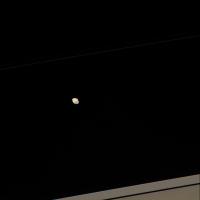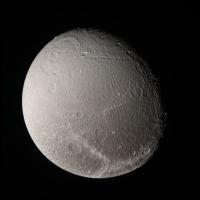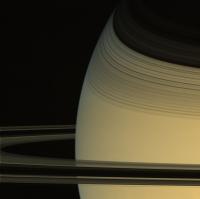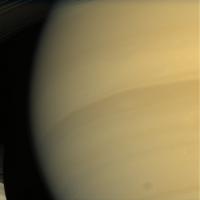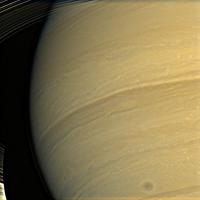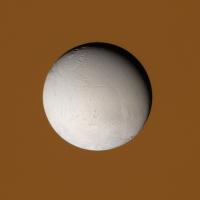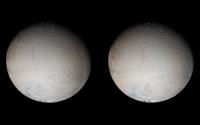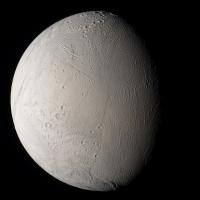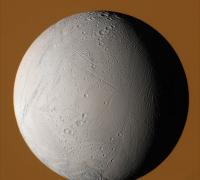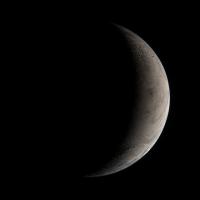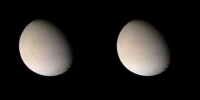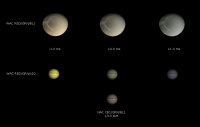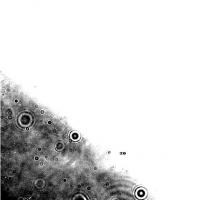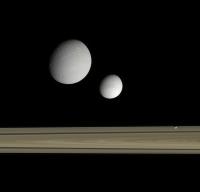Printable Version of Topic
Click here to view this topic in its original format
Unmanned Spaceflight.com _ Cassini general discussion and science results _ Some random Cassini stuff
Posted by: ugordan Jun 28 2006, 10:22 PM
Here's a very short, grayscale Rhea flyby movie made up from 10 Cassini clear frames. The frames were reduced to 3/4 original size to keep the thing reasonable. One could arguably make a 3d anaglyph because the vantage point changes quite a bit. Note that the sequence is clipped a bit because Rhea was filling the entire field of view. There's a noticeable dimming of surface features as the phase angle increases.  RHEA.mov ( 972.05K )
: 696
RHEA.mov ( 972.05K )
: 696
WARNING: Quicktime 7 and H.264 codec required!
Posted by: ugordan Jun 28 2006, 10:32 PM
Also, here are a couple of color composites I don't recall were previously released by CICLOPS team:
Prometheus in true color within the rings on the left, Dione RGB composite on the right. Dione's saturation was enhanced, but the thing is still very gray:
An R+B shot of Saturn with the unilluminated side of the rings present:
Another shot of Saturn's cloudtops, R+B, synthetic green. The image on the right was greatly enhanced to bring out the cloud features:
Posted by: Bjorn Jonsson Jun 29 2006, 11:15 PM
Great images although I'm not sure the color balance in the Saturn images is correct (however, that's something that can also be said of my own images ![]() ). I'm surprised more images processed from the Cassini PDS releases haven't appeared here, they are an absolute goldmine.
). I'm surprised more images processed from the Cassini PDS releases haven't appeared here, they are an absolute goldmine.
As a matter of curiosity, how did you make the synthetic green images ?
Posted by: ugordan Jun 30 2006, 07:41 AM
I simply used Photoshop's channel mixer. I used a balance of red and blue that produces this general color. I can't remember OTOH the exact mixes, but I do remember that red + blue add up to over 100% for the green. Generally, it's a pretty even mix with only a couple of percents more red than blue. I was aiming towards something looking like http://ciclops.org/view.php?id=1585 and to some extent http://www.astro.virginia.edu/~av4n/satfinal.jpg (courtesy of Anne Verbiscer).
You're right, there's a real goldmine in the PDS images, in fact I think the next batch of data should be released very soon, if not already.
BTW, since you're 'here', can you tell me if you're having any problems with flatfielding the WAC images? My code seems to work perfectly on NAC frames, but the WAC frames still end up with excessive static noise. I don't know if my code is faulty (which would be strange because it handles both NAC and WAC images the same way) or the provided wide angle flatfields aren't that good.
That sharpened cloud image above is distinctly noisy as can be seen.
Posted by: ugordan Jun 30 2006, 05:54 PM
Several Enceladus shots in stretched color:
Taken on 15 January 2005. Shows dimming with increasing phase angle.
These were taken on 16 February 2005. The brown darkground in the first image is Saturn's disk.
The right image one is a stereo pair intended to be viewed crossed eyes. The gamma of the image was lowered to bring out a little more details on the disc.
These three were taken March 9 2005.
EDIT: I removed two separate images from Feb 16 and replaced them with a stereo pair instead.
Posted by: volcanopele Jun 30 2006, 06:26 PM
What do you use for calibration? Some of those enceladus images are stretched very strangely. What filter combos are using?
Posted by: ugordan Jun 30 2006, 06:50 PM
I assume you're talking primarily about the uppermost image (3 shots)? That does look oddly colored to me as well. The same procedure I used to get the other images was also used on the first one. I don't know why it turned out with such a distinct hue. Maybe primarily the older, northern terrain is visible. The south polar region does appear bluish, though.
I use my own code which is still far from perfect.
The filter combo is IR1 and UV3. I used the GRN ones where available (which were regularly waaay out of perspective with the other two) to instead select parameters for a synthetic green image. The end result was effectively the same.
Posted by: volcanopele Jun 30 2006, 08:15 PM
using a synthetic green may be part of the problem...
Posted by: ugordan Jun 30 2006, 08:20 PM
The same thing happens if I use the real green channel, I tried it. Apart from color fringing it made practically no difference.
Here's what I mean:
The left one is using real green, right one is synthetic. I magnified the images 2x to show the color fringing that the green channel introduces (note the small crater).
For what it's worth, metadata for the above image says the sub-spacecraft latitude and longitude are 3.19 and 70.18 degrees, respectively.
Posted by: Bjorn Jonsson Jul 3 2006, 12:33 PM
That sharpened cloud image above is distinctly noisy as can be seen.
I don't see any obvious difference between calibrated NA and WA images in my case. The only 'difference' I have noticed is that compared to NA images the WA images are more often compressed aboard the spacecraft using lossy compression and because of this artifacts are sometimes visible.
When I calibrate the images the blue images always get rather dark. To make color composites I have to brighten the blue channel by a factor of ~2 compared to red. I wonder if you get similar results - in fact comparing images might be interesting because without 'groundtruth' images from CISSCAL debugging the code can be difficult when possible bugs are not visually obvious in the resulting images.
Posted by: ugordan Jul 3 2006, 12:46 PM
WA only or both NA and WA images?
I noticed wide angles are pretty tricky because they use on the order of 10x shorter exposures than NA (speaking OTOH). This makes that shutter offset fudge factor in cisscal quite important. I've experimented with Jupiter and Dione WA images, comparing them to similar NA images to come up with a different offset than what is used in cisscal (to match the resulting colors). Using the default offset definitely makes the WAC images look weird. I'll have to check the code when I get back home and maybe put up a few examples of what a 2 ms shutter offset difference does to a WA image.
As for NAC channel being too dark, does it happen to you all the time? When looking at a grey target, such as Dione, I get pretty normal results, not brownish or yellowish.
I do often wonder just how much CICLOPS team manipulates the color images to get a greater "awe factor".
Posted by: Bjorn Jonsson Jul 3 2006, 01:19 PM
I always get similar results for NA and WA, i.e. the blue images are dark. To get nice color composites I usually need to multiply G by a factor of ~1.3 and B by a factor of ~2 (this is from memory - the exact numbers are a bit different).
I suspect CICLOPS may manipulate the color to get more realistic results but having seen Jupiter and Saturn through a telescope I suspect the color may be too saturated even though something like Saturn would look different at close range - the effects of contrast (black sky) are remarkable. I remember how strange Jupiter and Saturn looked near the Moon's limb several years ago - they looked dark, very dark.
Processing color images of Saturn to roughly match what I see through a telescope and then applying identical processing to satellite images is one of the many things on my 'PDS/Cassini TODO list'.
IIRC I corrected a bug involving shutter offsets in my code several months ago. I'll have to check that part of my code tonight to see exactly what I did.
Posted by: ugordan Jul 3 2006, 05:20 PM
Here's an example of the effect of small changes in shutter offset. The top row is a Dione image using W1481738584_2.IMG, W1481738622_2.IMG and W1481738603_2.IMG. Three cases are shown and the resulting brightness ratios are also preserved. Note the brighter results when subtracting the value from the offset slope.
The second row is a Jupiter RGV image using W1352839344_2.IMG, W1352839385_1.IMG and W1352839450_1.IMG.
The brightness trend is even more obvious here. I also included a NAC frame taken at around the same time, but using a slightly different filter combo, CB1/GRN/BL1, primarily to compare the brightness and to a lesser extent color.
Based on the assumption the WA and NA images should be equally bright once the optics areas are taken into account as well as the ugly yellow color of both Dione and Jupiter, I'm inclined to say a -1.0 ms offset (which cisscal uses) is definitely wrong.
As I said before, WAC is very sensitive to this offset because the red and green exposures are typically 10 and 15 ms (compared to around 70 for blue) that a small shift makes a large change in output. NAC is much less sensitive to this as it uses much longer exposures.
Finally, I can't seem to reconcile the Jupiter and Dione appearances - gray Dione appears to suggest +1.0 ms is correct, while very bluish Jupiter at that setting suggests something slightly higher than 0.0 ms.
I'd definitely be interested if you come up with similar results or if my code is seriously messed up somehwere.
In short, I wouldn't trust the color of the wide angle shots without much more precise knowledge of the shutter response. The images officially released probably contain a fair bit of artistic freedom to them.
Posted by: Bjorn Jonsson Jul 4 2006, 12:58 AM
Regarding shutter offsets, I had a look at some code I modified several months ago and found this:
constoffset=1.0; // See comment in line 65 in cassimg__dividebyexpot.pro
// There is a bug in CISSCAL, the following line is missing. See section 4.3 in the Ground Calibration report.
if (cam=="ISSWA") constoffset=0.0;
for (i=0; i<numsamps; i++) buf[i]=expo-buf[i]-constoffset; // The true exposure at sample j
So apparently the shutter offset is 0 for the WAC.
IIRC the Ground Calibration report is on one of the calibration volumes (probably vol. 11).
Apparently this is correct and the offset should be 0.0 - see the code above.
Posted by: ugordan Jul 4 2006, 08:23 AM
Ah yes... that would explain why I also at one point included the check if the camera was NAC to subtract the constant offset. I failed to make a comment in the code why that was the case and later removed the check...
Thanks for finally clarifying this mess.
About the point of multiplying G and B by constant factors, I guess it all depends on what you consider realistic. What color do you get for example for low phase Enceladus shots without the factors? If it still turns out white, I'd say that's realistic. Of course, Saturn may wind up brown-yellowish then, but again -- how do we really know it doesn't actually look that way from those angles? I try to limit my processing in terms of color to changes in gamma/saturation, without multiplying individual channels by these magic numbers. Additional color balancing might be performed with weighed mixing of the 3 filters, but you need to have a correct white point for that as well.
The calibration procedure already has correction fudge factors built in so I take it they're the correct ones. The end result might look more dull and less colorful (barring any errors in my calibration code), but I prefer realistic (whatever that actually is) to plain pretty.
Posted by: ugordan Jul 4 2006, 05:11 PM
Here are two Saturn wide angle shots made of 2 footprints each. The one on the left is using RGV color, the one on the right is RGB for comparison. I performed no individual channel multiplications/corrections, only some sharpening and a gamma of 1.25 was applied.
http://img246.imageshack.us/my.php?image=rgv36tc.jpghttp://img196.imageshack.us/my.php?image=rgb34tm.jpg
Saturn's "blue cranium" only appears distinctly blue using the violet filter, while using the blue filter it turns out a very subdued bluish hue.
Posted by: tedstryk Jul 5 2006, 03:40 AM
Great images!
Posted by: RNeuhaus Jul 5 2006, 11:25 PM
Secrets Revealed in Saturnís Faintest Rings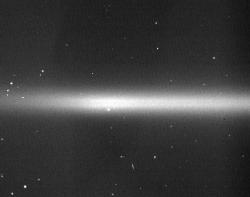
New photos of Saturnís E ring shows how it has a similar double-banded structure to Jupiterís ring. Thanks to data gathered by Cassini, scientists now believe that the E ring particles originate from water geysers on Saturnís moon Enceladus. The double-banded appearance occurs because there are actually less particles at the ring plane than there are above and below it. Scientists believe the double structure is created by the trajectory of particles ejected from Enceladus, or through ongoing interactions between the moon and the ring.
http://www.universetoday.com/2006/07/05/secrets-revealed-in-saturns-faintest-rings/
Rodolfo
Posted by: Toma B Jul 6 2006, 09:19 AM
Just been on Cassini raw images page and seen this:
http://saturn.jpl.nasa.gov/multimedia/images/raw/raw-images-details.cfm?feiImageID=78646
What are those concentic circles?
I think there is no rain in Saturns orbit...
Is there something wrong with the camera?
There are many more images like that one...http://saturn.jpl.nasa.gov/multimedia/images/raw/raw-images-list.cfm?browseLatest=1
Posted by: djellison Jul 6 2006, 09:21 AM
That's dust and other crud on the optics/ccd etc. They get pulled out ( mostly ) via calibration etc - but the raw JPG's can often really really show them well because they might be looking at a low contrast object and then get very heavily stretched.
Doug
Posted by: Bob Shaw Jul 6 2006, 11:40 AM
Doug
Doug:
Nah. It's Volcanopele's digital thumbprints!
Bob Shaw
Posted by: ugordan Jul 9 2006, 06:39 PM
Thanks. Here are a couple of Hyperion composites from the recently released data:
A true color, RGB view:
http://img508.imageshack.us/my.php?image=hyperionrgbnac8pq.jpg
This is probably more or less what Hyperion looks like, the officially released views so far stated the red hue was deliberately toned down in the releases.
A stretched color view, using IR, green and UV channel:
http://img370.imageshack.us/my.php?image=hyperion5tm.jpg
Image on the right is processed similarly to the CICLOPS releases, mapping differences in the predominantly reddish color. Note how Hyperion is much brighter in the infrared, hence the very red coloring. It's even more pronounced if you go further into the IR band.
Lastly, another attempt at a 3D image, a cross-eye view:
http://img69.imageshack.us/my.php?image=hyperionstereo4gs.jpg
It was composed using the 2 above views, the stretched color one was toned down to match the true color view.
Posted by: Bob Shaw Jul 9 2006, 08:09 PM
That 3-D view reveals one sick-looking puppy of a moon - rotting away before our very eyes!
Bob Shaw
Posted by: nprev Jul 9 2006, 09:32 PM
Thanks, UGordon...great images!!!
Bob's comment has a lot of validity...Hyperion has clearly been used & abused, much more so IMHO than any other object we've yet examined up close. I still think that it's a captured Centaur that made a pass or two through the rings, then encountered Titan & subsequently settled into its current orbit...bet that it was at least twice as massive (and spherical!) before these events.
Hmm. On that latter note, does anyone know if Cassini is looking for signs of outgassing along Hyperion's orbital path and/or during any forthcoming close encounters? If it is in fact an errant KBO, I would expect at least some sublimation of exotic ices above the background noise level if it's been in place less than 2 or 3 billion years. The thing certainly seems to have a wide variety of subsurface strata exposed to solar heating at odd intervals from all those craters...
Posted by: elakdawalla Jul 19 2006, 06:07 PM
I just got an automated email from the PDS announcing "Data Release 5" for Cassini, including ISS and VIMS data. I have a feeling that these automated announcements are often delayed by weeks, so I'm curious if anyone (ugordan?) knows if this is truly new as of today or has it been available for a while?
Here's the email:
Cassini data for the following instruments:
ISS
VIMS
To access the above data, please visit the following link:
http://pds.nasa.gov/subscription_service/PDS-Subscription-Service-19-Jul-06.html
To access the latest PDS Data Releases, please visit the following link:
http://pds.nasa.gov/subscription_service/PDS-Subscription-Service-Data-Release-Summary.html
All available PDS data may be downloaded from:
http://starbrite.jpl.nasa.gov/pds/index.jsp
For further information, see the PDS Home Page:
http://pds.nasa.gov/
Thank you for subscribing to the PDS Notification Service,
Posted by: volcanopele Jul 19 2006, 06:18 PM
Sorry, I haven't looked in on this thread in a while. ugordan, very nice Hyperion composites. You should try some of the mosaics. I'm curious to see what people with ptgui (I think it is called that) can do with Hyperion. Because of Hyperion's irregular shape and problematic rotation, I can't mosaic Hyperion using ISIS. A program that just morphs and stretches the images to fit together and doesn't care about the object's shape might be useful for this enterprise. A couple of my Hyperion mosaics were released, but I just did those in Photoshop.
Emily, Data Release 5 is this month's release. ISS delivered all of its July-Sep. 2005 data on June 29 (along with VIMS it would seem). Not sure about RSS.
Posted by: ugordan Jul 20 2006, 07:19 AM
Thanks, VP! It would be nice to have a reference for double-checking Hyperion's real color, though. So far CICLOPS hasn't released any such views and Voyager images are shifted and very saturated -- not very useful.
Emily: IIRC, the data was slated for release on July 5, but usually it starts appearing a few days earlier, but with limited availability. I think they mark the data release date when all the data is targeted to be available via online PDS search. You can have scenarios that the DVD volumes are available, but the search engine isn't updated yet.
So yes, the automated mail is "ages" old. These Hyperion images are in fact from the latest release.
Bjorn posted news of the data release and what it contains in http://www.unmannedspaceflight.com/index.php?s=&showtopic=2929&view=findpost&p=60534.
Posted by: AlexBlackwell Jul 20 2006, 06:19 PM
When it comes to Cassini PDS releases, Bjorn is usually far ahead of the listservs in letting us know. So if you want to cut down on the traffic to your email inbox, just look for Bjorn's posts instead
Posted by: ugordan Jul 20 2006, 06:38 PM
An approximately true color mosaic of Hyperion using 5 footprints taken simultaneously in IR1 and UV3:
http://img472.imageshack.us/my.php?image=hyperionmosaicli2.jpg
Since true RGB filtered images aren't available, I selected appropriate channel mixes for IR1 and UV3 to produce a result virtually identical to a RGB image. The footprints were scaled to the smallest one (the distance between footprints changed considerably!), they cover the entire disk except a small gap in the lower right limb portion, I used a clear frame there and colorized it to match the neighboring colors.
The stitching was done in Photoshop and should in no way be taken as geometrically accurate, some slight fudging was obviously required.
Posted by: Bjorn Jonsson Jul 20 2006, 08:28 PM
And now that I have finally taken a look at every image from the July 1 2006 release I have posted an updated summary of the PDS images at http://www.mmedia.is/bjj/misc/css_stuff/images/coiss_overview.html
(this 'summary' is getting so long that given the length of Cassini's mission I eventually need to make a summary of this summary)
Posted by: elakdawalla Jul 20 2006, 09:12 PM
You're a god, Bjorn. This page is awesome -- thank you for sharing it. And, if it's long, it's better to be one page; that makes it easier to search (or to import into some other software to be sorted and played with).
--Emily
Posted by: tedstryk Jul 22 2006, 02:13 AM
TTTHHHAAANNNKK YYYOOOUUU!!!!!!!!!
Posted by: ugordan Jul 24 2006, 05:56 PM
Here's something I wanted to find out for a while. It has been said that Iapetus' Cassini Regio and Hyperion have almost the same color. I did a crude experiment, using both stretched color and natural color views of the two moons. I selected a portion of a composite, averaged the color and compared the results. Here's what turned up:
Keep in mind the colors in question were greatly brightened - in reality Iapetus is much darker -- asphalt is often used for comparison. Also, the brightnesses were normalized so only the hue matters.
Using the infrared and ultraviolet filters, the materials differ ever so slightly, but in the approximately natural color view they are virtually indistinguishable. Cassini Regio's color certainly varies as much on larger scales.
The similarity is intriguing, though it should be taken with a grain of salt because the camera parameters in both cases probably weren't the same and then there's the dependency upon the phase angle and other parameters that can drown out any difference by themselves.
Nonetheless, I think it's interesting.
Posted by: elakdawalla Jul 24 2006, 06:05 PM
Cool comparison, ugordon. I'm not sure what it means, but it's interesting.
This reminds me that something I've been wanting to see for a long time is a composite view of Saturnian system bodies shown with the same processing applied across the board, to illustrate the differences (if any) in albedo and color among them. The mutual event shots make it clear that there are albedo differences among the grayer bodies such as Tethys, Dione, and Rhea. I'd love to see a montage of all the moons that would make clear their relative brightnesses -- seems like there should be enough photos available now to get a good set of views at similar phase angle to do this.
Posted by: Bill Harris Jul 24 2006, 10:31 PM
OK, Hyperion looks highly eroded and abused. It is the same color as Cassini Regio on Iapetus. Could Hyperion have provided the dark material to Iapetus when it "arrived"?
Just curious.
--Bill
Posted by: ugordan Jul 25 2006, 07:02 PM
I've been wanting to see that as well, because as I was fiddling with the PDS data, I noticed there were stark differences between brigthnesses of various moons. I was too lazy to make a systematic comparison until now.
Below is a montage of the major moons -- except Phoebe, I couldn't get a darn good RGB set on the PDS.
All composites are approximately true color and use the same brightness scaling. I used Enceladus as the reference maximum brigthness.
http://img69.imageshack.us/my.php?image=cahc9.jpg
The moons are from left to right:
Prometheus, Pandora, Mimas, Enceladus, Tethys, Dione, Rhea, Iapetus, Hyperion and Titan's limb on the right edge. All moons were scaled to the same scale, showing how they would appear to the narrow angle camera at a distance of 500 000 km.
A note on observed brightness -- it's a function of phase angle so I preferred a single phase angle or as close to it. It wasn't always possible, however. Notable exceptions are Prometheus and Pandora with phase angles of 10 and 19 deg, respectively. Other moons are at around 50 deg, except Dione and Rhea - 39 & 34 deg.
You may note that the leading hemisphere of Iapetus is practically invisible at this brightness scale. At albedo of around 0.04, the dark side is really pitch-black. Hyperion and Titan are very dim as well.
If I can dig-up a good RGB or IRGUV set of Phoebe, I might add it as well, but from what I've seen it's pretty gray and only slightly brighter than Cassini Regio.
Posted by: JRehling Jul 25 2006, 07:16 PM
[...]
the approximately natural color view they are virtually indistinguishable
I wonder if this wouldn't be true for all the icy moons of the outer planets, with brightness (iciness) as the only independent variable. In other words, as you move from the brightest white of Enceladus to the darkest "black" of Iapetus, do you define a smooth line through color space with the lighter and darker surfaces of Europa, Rhea, Tethys, Dione, Ganymede, Callisto, Iapetus (and several intermediary values for other moons... sometimes more than one terrain type per world)? In other words, do the compounds darkening those surfaces all have a similar spectrum? I am 100% sure that with detailed spectral analysis, there are differences (even Europa alone shows IR-bright and IR-dark patches), but using RGB alone, we might not see it, no matter which pair of worlds we choose. That's my hunch.
Posted by: elakdawalla Jul 25 2006, 07:16 PM
If you're lazy, what does that make me, sitting back here and dropping broad hints at work that I'd like other people to do for me?
Thanks for doing this. I knew there were differences but I hadn't realized just how different the albedos would be; I especially didn't realize just how dark Titan was. That's pretty cool. It looks like Tethys and Rhea are a little more reddish than Dione -- is that impression correct? If so, that's interesting too. Hmm. Neat stuff.
--Emily
Posted by: ugordan Jul 25 2006, 07:27 PM
Someone once said: The more I want to get something done, the less I call it work.
I'd call it a labor of love, but it wasn't all that laborious, really
Yep, Dione looks really gray in natural colors. Suspiciously gray even. Things get interesting when you go into stretched color, IR and UV -- the darker stuff has a weird spectra to it, IIRC.
Posted by: AlexBlackwell Jul 25 2006, 10:13 PM
I don't know but for some reason I'm reminded of http://www.pbs.org/marktwain/learnmore/writings_tom.html.
I'm just joking, of course. At least you give credit, Emily, unlike, for example, Jim Oberg, who was (and probably still is) pretty effective at Tomsawyering his acolytes on USENET. Typically, he starts out with something like, "Hey, I'm working on a story about X and I need answers to the following fifteen questions. Thanks in advance, you guys are the greatest!"
Posted by: dilo Aug 2 2006, 09:08 PM
It seems Cassini is dooing some astronomy sequences, here a registax sum of last four Narrow-angle images with removed (flattened) horizontal stripes:
Can someone guess where we are looking to?
Posted by: akuo Aug 2 2006, 09:40 PM
The NAC field of view being only 0.35 x 0.35 degrees, you can't really recognise any constellations :). I guess that's some open cluster in the middle.
Posted by: volcanopele Aug 2 2006, 10:16 PM
It's M48: http://www.seds.org/messier/m/m048.html
Posted by: dilo Aug 2 2006, 10:19 PM
Wow, tanks Jason... you're magician or you are working for Cassini team?
(I know the answer ![]() )
)
Posted by: ugordan Aug 17 2006, 09:17 PM
Here's a couple of images that were officially released, but presented here with an additional 'twist'.
Dione with Saturn as backdrop:
http://img450.imageshack.us/my.php?image=diwaxe2.jpghttp://img130.imageshack.us/my.php?image=dinaoo8.jpg
The image on the left is actually a wide angle context for the right one which is narrow angle and AFAIK wasn't released.
An image of Titan's haze layers:
http://img174.imageshack.us/my.php?image=titan1zb9.jpghttp://img130.imageshack.us/my.php?image=titan2aw5.jpg
The right-hand image has the gamma kicked up to show the detached haze layers and how much they tower up above the visible limb.
Posted by: Jyril Aug 17 2006, 09:57 PM
The bottom-left view of Titan is the best one I've ever seen on Titan's clouds. ![]()
Posted by: ugordan Aug 23 2006, 06:06 PM
I've just dug up an awesome RGB set from the PDS showing Dione, Tethys, Pandora and the rings in color:
It's color composites like this that I wish the imaging team would release more often. Much nicer than churning out grayscales every day, IMHO.
The images out of this set that were released are http://ciclops.org/view.php?id=1472 and http://ciclops.org/view.php?id=1473.
There's a bunch of gems like these waiting at the PDS. I've set up sort of a gallery where I'll post new composites on the fly in order not to trash this place too much. It's easier to browse through the images that way anyway. The only downside is the size limitation of 1024 pixels for the free account so no large mosaics until I upgrade the account.
I've put up most of the images already shown here, though the processing was corrected for them after I realized the red channel was a tad too bright for some reason, while I was creating that albedo/color montage. This is why those Enceladus shots got reddish, as well as Hyperion and.. well, most first ones.
I've finally been able to get a grip on narrow-angle and especially wide-angle camera quirks and am fairly pleased with the results. You can find the gallery at http://www.flickr.com/photos/ugordan.
Posted by: David Aug 23 2006, 06:39 PM
Those are really super images. I especially like the one of Io against Jupiter's limb.
They can't send me on a mission to Jupiter -- I'd be completely useless, as I'd spend all my time staring out the window.
Posted by: Floyd Sep 6 2006, 12:37 PM
The photos of the rings that were posted today show quite dramatic changes in the appearance Encke division from frame to frame. If anyone could put the pictures together in a movie, I think it would be quite interesting.
Powered by Invision Power Board (http://www.invisionboard.com)
© Invision Power Services (http://www.invisionpower.com)
